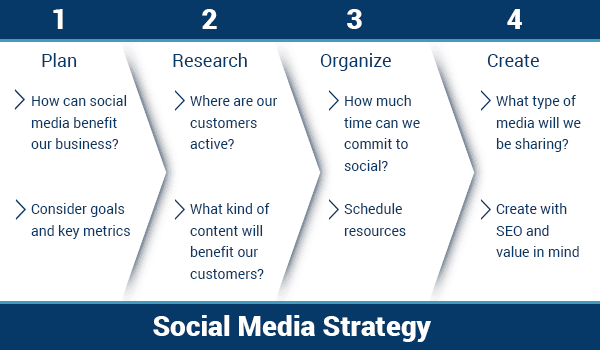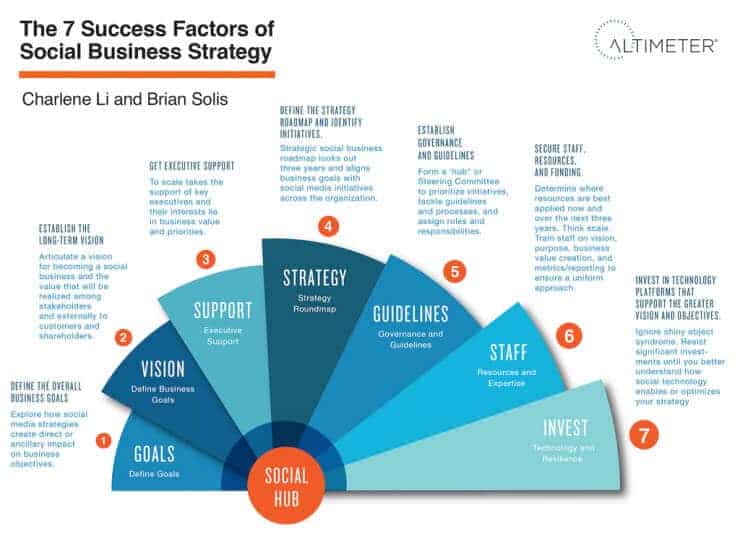[1]Based on interviews with organisations that are investing in social media at varying levels, we learned that there are notable differences that exist between companies implementing a social media strategy and those that are building a social business. A social media strategy lays out the channels, platforms, and tactics to support publishing, listening, and engagement. We define a social business strategy as:
The deep integration of social media and social methodologies into the organization to drive business impact.
Social Media Strategy
[2] Social media strategy lays out the channels, platforms and tactics to support publishing, listening and engagement. A social business strategy is the integration of social technologies and processes into business values, processes, and practices to build relationships and spark conversation inside and outside the organization, creating value and optimizing impact for customer and the business alike.

Figure 1: Social media strategy (Source: Complete spectrum. 2014, January)
Mass media marketing is slowly dying and essentially they monitor social media to provide news items; think of the latest Kayne West news that originated from his Twitter account that every newspaper picked up and ran stories on. [3]Social media can no longer be ignored by organisations that claim to be customer-led or customer focused. Businesses now use social media to share their voice and information. Social media starts with business goals or direction, either the need to be social because everyone else is social or a strategic plan of attack. The later is the better business strategy where the organisation knows what their goals are for social media.
“Becoming a social business transforms the organisation from the inside out, connecting the internal with the external in a way that enhances relationships and creates shared value for the people, the business and ecosystem as a whole.”
Business goals need to support their social media strategy and vice versa, the social strategy should align and serve the companies objectives. Social media is alive it’s an organism that needs constant conversations, monitoring – feedback loops, creative content and analysis then rinse and repeat. Barriers that implement the social media strategy will increase its demise
Social Business Strategy

Figure 2: Social business strategy (Source: Altimeter Group. 2015)
Unplanned social media sometimes happens from the bottom up; we should do social media because we should do social media, with little focus just letting it slowly grow essentially shutting the barn door after the horse has left. If the organisation wants to be successful they need to guide the use of social media and allow organic growth. The social business strategy has to clearly align with strategic business goals and provide full support that enables execution and growth of the strategy.
The Altimeter report focuses on six stages of maturity development in the social business strategy, each stage becoming stronger and becoming closer to a social business:
- Planning – which is foundation building
Listen to customers
Pilot projects
Assess competitors – look for gaps and opportunities
Define goals
Monitor social media platforms
Report your findings
Identify future opportunities - Presence – grab your accounts that are consistent with the business strategy.
Control the management of the accounts and set boundaries – content guidelines
Gather assets - Engagement – shows commitment
Highly important in customer engagement and customer lifecycle
Introducing value
Shareable content
Consistent conversations
Provide support
Start amplifying existing efforts
Create rules for engagement
Understand metrics
Share statistics with all levels of management
Plan for scale
Rinse and repeat - Formalised – sticking to the plan of attack, not uncontrolled initiatives
Executive Sponsor – the go-to guy
Center of Excellence (CoE)– social strategy governance, initiatives, and technology
Planning and organizing for scale - Development
Governance
policies, processes, Playbook, technologies, training - Strategic – gaining greater visibility and with that acknowledgment and
movement into all areas of business
engagement in all areas of business
Steering committees that work with the CoE
Generate executive buy-in
Integrate CoE into all areas of business
Data analysis to break down the details - Converged – become a social business, where social media is woven through all areas of the business and understands the social existence and transactions of it. Where there is one strategy for business and marketing directions not separate components
What are the success factors of social business strategy?
Alignment.. Alignment.. Alignment.. there needs to be executive and hierarchy buy-in and alignment with business objects and marketing goals. If this is not in place business development plans and goals will not include social business strategy steps and the real possibility of social media brought in after the project has been developed or is approaching being launched. Included in the long-term vision and have a consistent budget regarding social media strategies, often businesses will look at 6 months or 1 year down the track and plan media initiatives’ then budgets move up and down in scale and inconsistency occurs. Department silo’s need to be joined and social media marketing becomes one within in the organisation. Here are Altimeter seven success factors to a social business strategy:

Figure 3: 7 Factors (Source: Solis, Brian. 2015)
- Define the overall business goals. You can’t align your social strategy with your business objectives if you don’t even know what your objectives are. Define and refine.
- Establish the long term vision. If you’re not striving toward the end goal, you’re likely to veer off the path. If you want your team to fully invest in your social strategy and you need the support of your entire team you’ll need to communicate your vision with clarity and passion.
- Ensure executive support. In the early days you may be able to fly under the radar, but at some point, if you want to truly have an impact on the business, you’ll need the backing and support of key executives.
- Define the strategy roadmap. You already know your business objectives and have a clear vision. But how are you going to get there? Plan out your route, what roads you’ll travel, and what roads you’ll avoid.
- Establish governance and guidelines. Who is responsible for executing the social strategy? What’s your process for listening and responding to your customers? If you clearly define this process and then stick to it, you’ll spend less time floating along throughout the social sphere and more time strategizing your social growth.
- Secure staff, resources, and funding. In the early stages of social growth, you might outsource your social media campaign to an agency, and that’s fine. But you should also be looking down the road and planning to develop internal resources to take your company to the next level as your social prowess and your business grows.
- Invest in technology platforms that evolve. Resist the temptation to jump on the latest technology bandwagon before you have a long-term strategic plan in place. Hold off on making significant technology investments until you’re equipped with a sound vision and strategic plan.
working through the steps of the social business strategy can develop a forward thinking company that is more than lip service regarding social media and its business intentions. From Generation Z and beyond these are children will change our social and marketing environment. Organizations have to understand that social is here to stay and it’s a valuable ever evolving component to the business.
And now for some fun – the red cross should have implement a policy not to use your own social media accounts at work!

Figure 4: Red Cross (Source: Red Cross 2011, February)
References
[1] Li, Charlene, Solis Brian. (2015, April 18) The Seven Success Factors of Social Media Business. Retrieved from http://www.briansolis.com/2015/04/7-success-factors-social-business-strategy-infographic/
[2] Solis, Brian. (2013, March 3). Evolution of social business. Retrieved from http://altimetergroup.wpengine.netdna-cdn.com/wp-content/uploads/2013/03/Altimeter_Evolution_Social_Business_FINAL_030613.pdf
[3] KPMG. (2011). Social media: The voyage of discovery for business. KPMG Research Report, July, Sydney
Li, C. & Solis, B. (2013). The evolution of social business: Six stages of social business transformation. Altimeter Group.
Weber, Larry (2011) . Comprehensive Digital Strategy or Business for the Social Media Era Everywhere Retrieved from https://books.google.co.nz/books?id=fk6uvAeBbccC&pg=PA61&lpg=PA61&dq=social+media+council+coke+cola+linda+cronin&source=bl&ots=tcMge23cC3&sig=IA_vqUTtj81zd7QTPhKB2chyOsg&hl=en&sa=X&ved=0ahUKEwi3hZ-FjuLMAhWCrJQKHWDqBKcQ6AEIITAA#v=onepage&q=social%20media%20council%20coke%20cola%20linda%20cronin&f=false
Image
Social business strategy. (2014, January). Essential aspects of social media strategy for business. [Image]. Retrieved from http://www.completespec.com/essential-aspects-social-media-strategy-businesses/
Altimeter Group. (2015). Social media Strategy [Image]. Retrieved from http://www.altimetergroup.com/work-with-us/challenges-we-solve/social-business-strategy/
Solis, Brian. (2015). 7 Factors. [Image]. Retrieved from http://www.altimetergroup.com/work-with-us/challenges-we-solve/social-business-strategy/
Red Cross (2011, February) [Image]. Retrieved from http://seapointdig.com/wp-content/uploads/2015/08/red-cross.jpg
Recent Comments